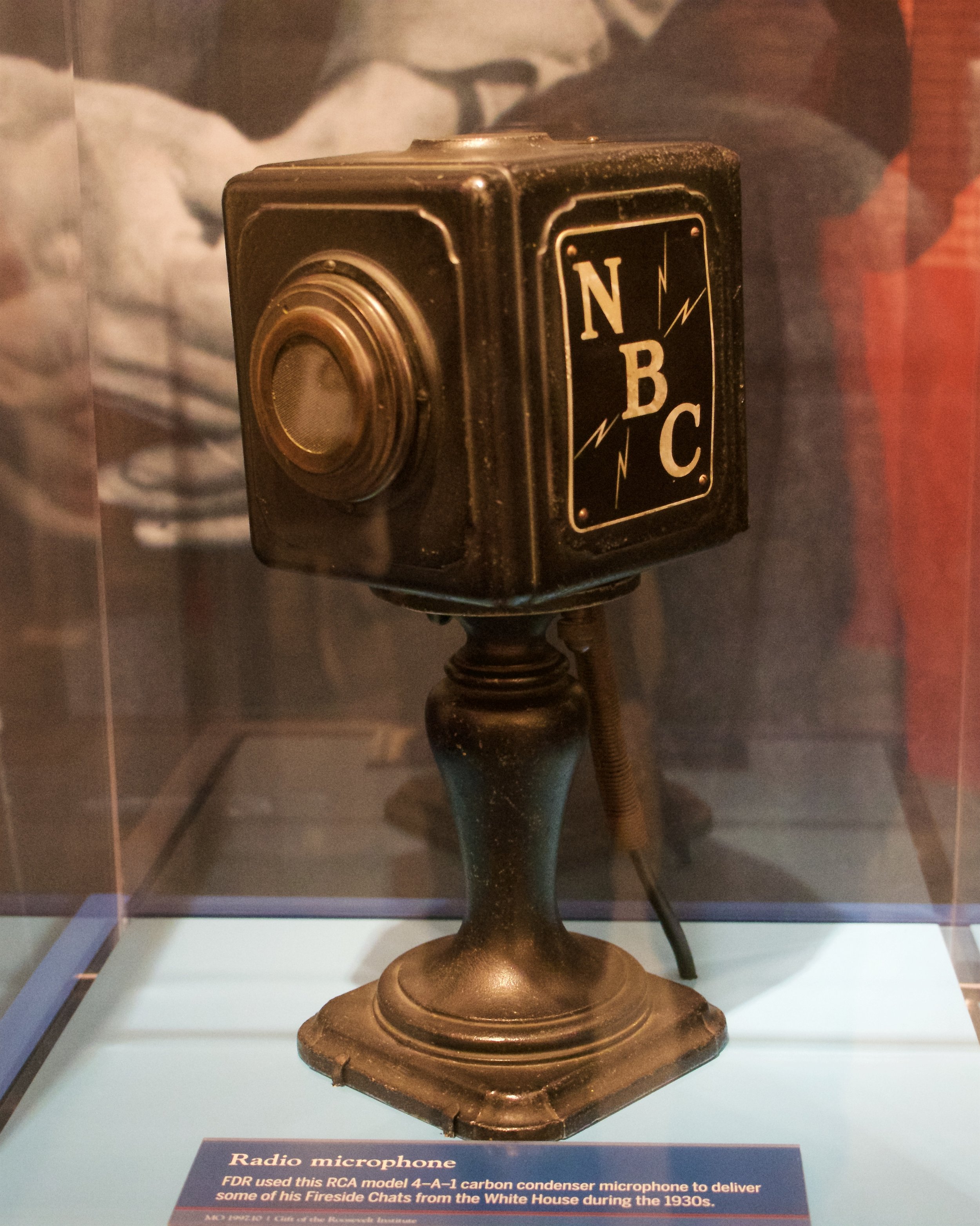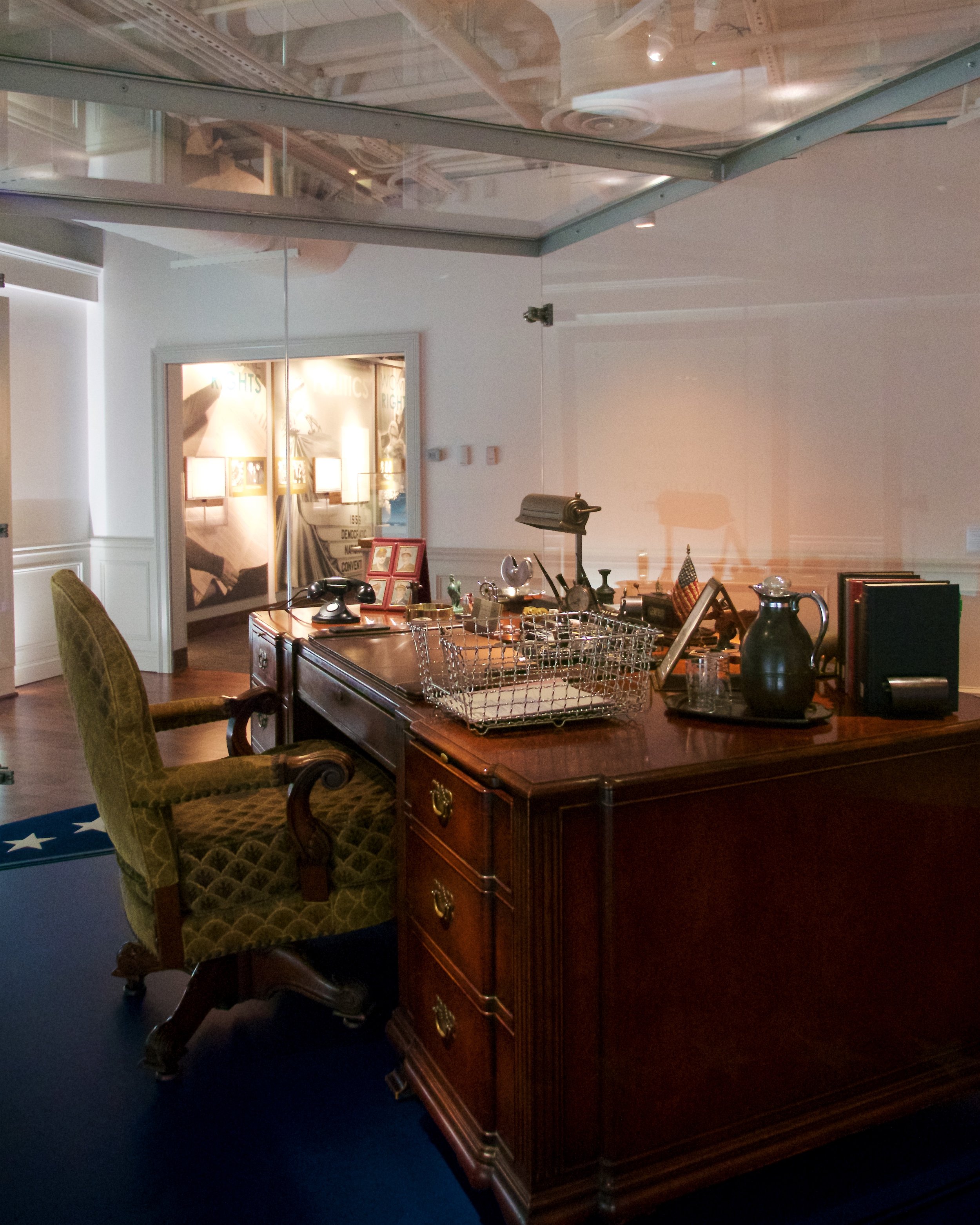Hyde Park, 7-Apr-2018
Even though we'd only been in New York for a couple nights, we took an overnight side-trip to the Hudson River Valley. Our plans for the day were to visit the FDR Library and Museum, then have dinner at the Culinary Institute of America.
The first thing we needed to do is pick up a rental car. Prices were much lower renting from an airport, so we took the train and a bus to LaGuardia to pick up the car. That went pretty smoothly, and we were soon on our way.
We pulled into the parking lot at the FDR Library right on schedule and went in to purchase tickets. Our plan was to get tickets for the 1:30pm house tour, eat lunch, then go on the tour, followed by looking through the museum. Ended up that the only tour not yet sold out was the one at 4pm, so it was time to change plans. The CIA restaurant we were planning on having dinner closes at 6:30pm, so we decided to go there for lunch instead, then return to go through the museum and tour the house.
Lunch at The Tavern
The campus for the Culinary Institute of America is only a few minutes away. We ended up driving around quite a bit of the campus before getting to the parking garage; the signs indicating pedestrian crossings had the addition of chef's hats, which amused us.
When you leave the garage, you walk up to a huge plaza in front of Roth Hall, the huge main building where we were going. We made a beeline to the American Bounty restaurant, where The Tavern is located (and does not require reservations). We weren't extremely hungry, so we decided to split soup, an entrée, and dessert. Ordering was quick, and while we were waiting we were given some garlic-black pepper popcorn to snack on. We had gone through most of it by the time our cauliflower soup arrived, and the server went to refill the popcorn.
The soup was quite thick, and the candied oranges added a nice sweet accent. We finished, and the bowl was whisked away. Then a few minutes later, another bowl of soup arrived and quickly taken away when we mentioned that we had already been served soup (this was the only misstep during our whole meal).
The Paella had blood sausage, shrimp, and mussels. We started divvying things up, but Melody had a mussel shell with no meat, but I found it not too far away. Not surprisingly, the dish was very tasty, and the sausage was very tender. They were also pretty generous with the saffron.
Dessert was a buttermilk panna cotta with a strawberry rhubarb compote, topped with an oatmeal crumble. It had a really good balance of sweetness, as well as very interesting textures.
Having enjoyed our meal, we wandered around a bit, dodging out of the way of the occasional culinary student running through the front door or across the plaza.
FDR Library and Museum
We returned to the FDR Library and Museum and noticed that we had just missed the start of the introductory movie. We went ahead to the Museum building and started working our way through the exhibits.
Unsurprisingly, the museum is laid out chronologically, including showing his ancestors from the Revolutionary years. It didn't take long to get into the presidential years, especially since there were so many of them to cover.
A lot of space was dedicated to the Depression years and even more for World War II. I kept my eyes out for a mention of the Japanese American incarceration, and there was one panel dedicated to it. It's understandable that a museum for a president would want to downplay negative aspects, but there were a couple times they directly called the incarceration an injustice. Also, it made clear that Eleanor Roosevelt was against the order, and there was a photo of her visiting the Gila River camp, where my dad was.
One of the rooms in the museum was FDR's original office, which included a wheelchair. A later tour guide would point out that he didn't use a normal wheelchair, but one made out of a modified dining chair. The reason was to call as little attention as possible to the fact that he couldn't walk.
In the basement was the desk FDR used in the Oval Office, as well as all of his belongings that he would keep on it. There was also the 1936 Ford Phaeton that FDR had modified so he could drive it with his hands. After his death, Eleanor used the car.
Once done with the museum, we walked back to the visitor center, got a quick snack from the café, then sat down to watch the introduction movie. By the time it finished, there were only a few more minutes before our tour was to start, so we went to the mosaic of the land that FDR's family owned which showed all the various buildings. The park ranger began his introductions, then guided us over to FDR's house.
The ranger's narration was very thorough and covered all the aspects of FDR's life as it applied to the house. Since FDR tried very hard to hide his inability to walk, there was a whole routine for him to receive visitors: he would be wheeled down a ramp to his library, be seated behind the desk, have his legs crossed, then once people had removed the ramp, the guest would be shown in, none the wiser.
Another aspect of the house related to his immobility was the elevator to the second floor, It was hidden around a corner on the first floor where FDR would enter, then pull on a rope to raise himself. He would then exit and go to the opposite side of the house where his bedroom was. The elevator was hand-operated even though electricity was available at the time; FDR was afraid of a fire and the electricity going out, trapping him either in the elevator or on an upper floor.
FDR's mother Sara died only a few years before he did. This is significant because FDR's father died before he was old enough to inherit the property, so it went to his mother, who held ownership until her death. Sara had the large room at the end of the South Wing's second floor, Eleanor used the small room next to that, and FDR the larger room next to Eleanor. That meant Eleanor was in between FDR and Sara, and those three rooms had connecting doors. While Sara was alive, Eleanor preferred to stay at her home at Val-Kill, further east on the property, but if FDR was also there, she would be in the main house.
After the tour, we walked into the rose garden where FDR, Eleanor, and their dogs Fala and Chief are buried.
Rest of the day
We got back on the road to make the short trip to New Paltz where we were staying at the hostel. After checking in and dropping off our bags, we found a grocery store where we could get breakfast items and things to have for dinner. We made quick work of the meal and settled in for the night. As the evening went on, the people in the room next to us started up what seemed to be a party. Usually, we know that gatherings like that usually die down, but they were still going strong (and getting louder) as it got to 11pm. I went over to ask them to keep it down so we could sleep, and there were 15–20 people in the tiny room, playing pretty loud music, and jumping up and down. Yeah, good thing I mentioned something. They were nice about it and quieted down after a few minutes, and we called it a night.


















